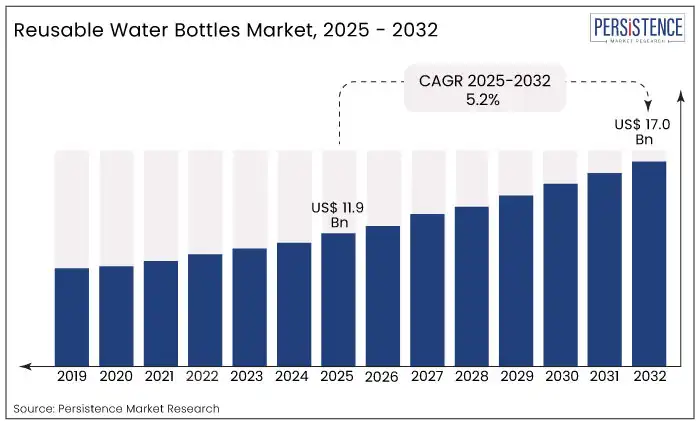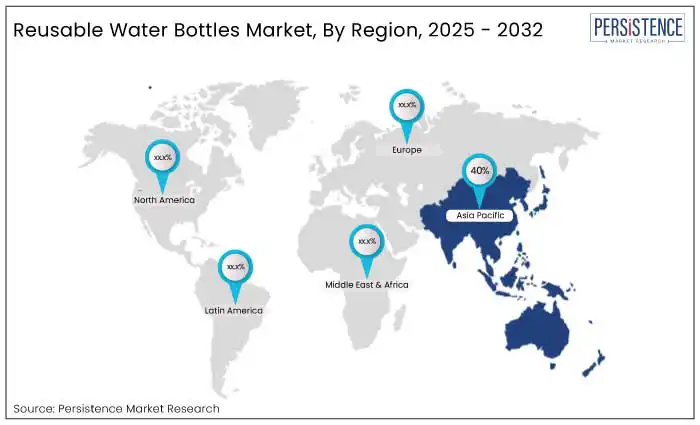Industry: Consumer Goods
Published Date: April-2025
Format: PPT*, PDF, EXCEL
Delivery Timelines: Contact Sales
Number of Pages: 183
Report ID: PMRREP32462
The reusable water bottles market is estimated to increase from US$ 11.9 Bn in 2025 to US$ 17.0 Bn by 2032. The market is projected to record a CAGR of 5.2% during the forecast period from 2025 to 2032. Customization trends, such as personalized designs and branding, are anticipated to bolster the market.
Increasing plastic pollution across the globe is another key factor augmenting demand. According to the Organization for Economic Co-operation and Development (OECD), nearly 109 million tons of plastic waste is in rivers and 30 million tons is in the ocean. The numbers are likely to increase at a fast pace if the use of single-use plastic is not controlled. Hence, consumers are becoming more conscious of the products they use, thereby creating new opportunities.

Key Highlights of the Market
|
Market Attributes |
Key Insights |
|
Reusable Water Bottles Market Size (2025E) |
US$ 11.9 Bn |
|
Projected Market Value (2032F) |
US$ 17.0 Bn |
|
Global Market Growth Rate (CAGR 2025 to 2032) |
5.2% |
|
Historical Market Growth Rate (CAGR 2019 to 2024) |
4.5% |
|
Region |
Market Share in 2024 |
|
Asia Pacific |
40% |
Asia Pacific is anticipated to account for 40% of the reusable water bottles market share in 2025. Recognizing the hazards of plastic water bottles, government bodies are vigorously encouraging manufacturers to utilize environmentally friendly and sustainable materials. This trend is expected to promote the active usage of reusable bottles among customers in the region.
India is one of the rapidly expanding target areas for companies in Asia Pacific. Booming e-commerce industry, a broad array of product choices, and easy availability of cheap glass water bottles are anticipated to boost sales.
China is set to rise at a CAGR of 7% from 2025 to 2032. It is due to the country's established manufacturing sector, rising population, and acceptance of reusable alkaline water bottles.

|
Category |
Market Share in 2025 |
|
Material Type- Metal |
54% |
Based on material type, the market is divided into polymer, metal, glass and silicone. Among these, the metal category dominates the market due to its high durability and affordability.
Stainless steel, for instance, assures users of zero pollutants and rust-free use even after several washings. For usage outside, clear metal water bottles are considered the ideal option. Brands are hence targeting campers, hikers, and fishermen to increase sales. These bottles provide resilience and toughness. Owing to the aforementioned factors, the metal segment is expected to register a market share of 54% in 2025.
Several prominent market players are developing their research and development efforts to provide high-quality reusable water bottle goods. As a result of more product advances that support a fiercely competitive sector, sales of reusable water bottles are rising.
|
Category |
Market Share in 2025 |
|
Sales Channel- Hypermarkets/Supermarkets |
38% |
Based on sales channel, the market is classified into direct sales, supermarkets/hypermarkets, specialty stores, independent stores, and online retailers. Out of these, the supermarkets/hypermarkets segment dominates the market with a share of 38% in 2025.
Growth of the segment is attributed to the adoption of strategic planning. Also, supermarkets and hypermarkets provide consumers with a wide range of products under one roof, which further raises convenience. This helps them make ideal purchase decisions after comparing prices, quality, and brand image. A few hypermarkets and supermarkets also offer doorstep delivery services, which appeal to busy consumers.
Reusable water bottles are in high demand due to the rising issue of plastic pollution and the harm that single-use and non-disposable plastic bottles cause to the environment. As consumers seek a healthy lifestyle, refillable drink bottles are becoming increasingly popular across homes, offices, universities, and schools.
BPA-free dishwasher safe water bottles aid in reducing landfills, which are a key contributor to both groundwater and subsurface contamination. Another factor encouraging the usage of reusable plastic water bottles is the rising consumer awareness of the negative environmental consequences of single-use and non-disposable plastic bottles.
Reusable water bottles are now considered essential worldwide. Several businesses in the industry are producing bottles with built-in mechanisms that make them simple to use in response to the rising demand for reusable products.
A variety of companies make filtered water bottles, and each one has a unique design. There are bottles with unique designs that filter the water as one pours or consumes it. Apart from these variations, all water bottles with filters have the same purpose, i.e. to filter out a specific quantity of contaminants or pollutants from the water. Several companies are striving to attract a large consumer base by launching such cutting-edge bottles. For instance,
Between 2019 and 2024, demand for reusable water bottles recorded a 4.5% CAGR. These bottles were widely accepted as an alternative to single-use plastic bottles due to their various advantages compared to plastic ones.
Plastic bottles contain BPA or bisphenol A, a chemical substance that can lead to cancer and is particularly bad for the environment. Emissions from producing disposable water bottles and delivering them to supermarkets are detrimental to the environment. The number of pollutants in the air increases as more bottles are created.
The market is likely to witness a CAGR of 5.2% during the estimated period. It is attributed to increasing production of new bottles with BPA-free labels. Due to the health advantages of glass and stainless steel, consumers are shifting their preferences in favor of these materials. As glass does not break down after repeated usage and washings, these water bottles remain germ and contamination-free even after several washings. This factor is expected to create new opportunities for manufacturers.
Emergence of BPA-free and Leak-proof Materials to Fuel Demand
Reusable water bottle demand is anticipated to rise during the evaluation period due to growing health concerns and increasing consumer knowledge of the product's availability. Furthermore, these bottles have gained traction as prominent brands have supported the adoption of sustainable manufacturing technologies. For instance,
As concerns about potential environmental disasters have surged, the energy sector has started to move toward sustainability. This shift has been further fueled by the calls for a change in lifestyle from international environmental and climate change monitoring organizations. Their influence has significantly boosted the global demand for reusable drink bottles. As a result, sustainable approaches and continuous technological innovations are set to encourage market growth.
Governments and Private Agencies Implement Zero-waste Norms to Bolster Sales
Corporate responsibility and government regulations are anticipated to bolster the global reusable water bottles market growth through 2032. Various private firms and government agencies are adopting zero-waste policies or encouraging sustainable practices among employees and customers.
Several tech giants and corporate offices, for instance, provide employees with refillable water bottles to discourage the use of disposable plastics, creating a culture of sustainability. Governments worldwide are also stepping up with regulations on plastic use, bans on single-use plastics, and campaigns encouraging consumers to shift toward eco-friendly alternatives.
In cities like San Francisco and Seattle, bans on single-use plastic bottles and containers in government facilities are becoming increasingly common, thereby driving demand. This institutional backing influences consumer behavior and allows brands to partner with corporations and public agencies to promote sustainable water bottle use, supporting growth.
High Convenience of Disposable Alternatives May Limit Sales
The high convenience of single-use plastic bottles continues to challenge the reusable water bottle industry. Disposable bottles are readily available, lightweight, and easy to carry. These make them convenient for consumers who prioritize ease and portability, particularly when traveling or when carrying and refilling a reusable bottle may not be feasible.
Single-use options also eliminate the need to clean, refill, or remember to bring a reusable bottle, which can appeal to busy or less environmentally focused consumers. Additionally, a few consumers may forget or lose their reusable bottles, leading them to revert to the more convenient, disposable option.
Despite the environmental benefits of reusable bottles, the challenge of competing with the sheer convenience and widespread availability of single-use bottles remains a significant barrier. It requires brands to innovate in ways that make reusable bottles more accessible and user-friendly in various contexts.
Brands Focus on Launching Plant-based Plastic and Recycled Steel to Attract Consumers
The shift toward sustainability has spurred a promising opportunity for innovation in eco-friendly materials and sustainable production practices. Brands are increasingly exploring materials like recycled stainless steel, biodegradable polymers, and plant-based plastics to meet consumer demand for green products.
By incorporating the aforementioned materials, companies can appeal to environmentally conscious consumers who prioritize the entire lifecycle impact of their purchases. For example, Nalgene’s Sustain line uses recycled plastic resins. Other brands are also looking into compostable or naturally sourced materials.
Adopting sustainable manufacturing processes, such as reducing water and energy use or minimizing carbon emissions, can strengthen a brand’s environmental credentials. This focus on sustainability differentiates them and aligns with the rising number of eco-regulations.
It is further anticipated to help in creating compliance and marketing opportunities by selling reusable branded water bottles. Eco-friendly materials represent a chance for brands to lead responsible innovation, attracting customers seeking authenticity and purpose-driven products. For example,
In 2024, Klean Kanteen, headquartered in California, made substantial strides in sustainable manufacturing by achieving carbon-neutral certification for its operations.
The reusable water containers industry is highly competitive, with key players including Hydro Flask, S'well, Nalgene, Klean Kanteen, and CamelBak dominating due to strong brand recognition, quality, and sustainable practices. These brands are known for continuous innovation. They are offering products with advanced features like insulation, filtration, and eco-friendly materials to attract health-conscious and environmentally aware consumers.
The market also includes various small-scale brands and new entrants, particularly those focused on affordability and niche customization options. Increased need for sustainability has compelled reputed brands to adopt recycled or biodegradable materials as well as sustainable manufacturing processes, such as carbon-neutral operations. This competitive focus on environmental responsibility and high-quality features drives market growth and differentiates brands in an increasingly eco-conscious consumer landscape.
Recent Industry Developments
|
Attributes |
Details |
|
Forecast Period |
2025 to 2032 |
|
Historical Data Available for |
2019 to 2024 |
| Market Analysis Units | Value: US$ Bn/Mn, Volume: As applicable |
|
Key Regions Covered |
|
|
Key Market Segments Covered |
|
|
Key Companies Profiled in the Report |
|
| Report Highlights |
|
|
Customization and Pricing |
Available upon request |
By Product Type
By Material Type
By Primary Usage
By Size
By Price Range
By Sales Channel
By Region
To know more about delivery timeline for this report Contact Sales

The market is expected to reach US$ 17.0 billion by 2032.
The market size is projected at US$ 11.9 billion in 2025.
The market is forecasted to grow at a CAGR of 5.2% during this period.
Metal reusable bottles are leading with a 54% market share in 2025 due to their durability and rust-free properties.